“We have an older couple, Mr. and Mrs. B. M. Hingeley in regular attendance every Sunday morning. His grandfather, Ezra Hingeley, was one of two young Methodist preachers downtown who took Sunday about to walk nearly . . . to Wilkinsburg to preach to a handful of people in homes or in fields. In 1832 we were put on a circuit with organized classes at Butler St., Emory, Wilkinsburg, Swissvale, Turtle Creek and McKeesport.”
–Edna Rigg Brown
“In 1843, with only 24 devoted members, a one roomed brick church was built, 40 x 50 ft., on the lot now occupied by the Baptist Church. During the Sunday School hour, the youngest children were grouped in the ‘Amen Comer.’ We still had the ‘Amen Comer’ until the fire of 1907, but it had become much less vocal thru the years. The lot was given by Mr. James Kelly, a charitable man who owned much land in Wilkinsburg. This was the first church building within the 1843 bounds of Wilkinsburg.”
–Edna Rigg Brown
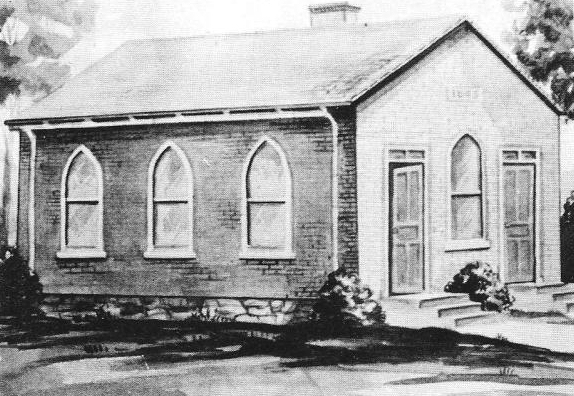
on the northwest corner of Wallace Ave. near Center St.
“This is South Avenue Church,” 1982, Wilkinsburg Public Library Digital Archives
The congregation began as the Wilkinsburg Methodist Episcopal Church.
“During the pastorate of Rev. W. D. Slease in 1876 a protracted meeting resulted in the accession of 137 members and the building was too small. Two proposals were considered: one to enlarge the existing building and the other to build on a new site on South Avenue, but being disappointed in securing the desired lot, and although several thousand dollars had been subscribed for a new church, it was decided to enlarge the old one, and a vestibule and bell tower were added to the front. . . . At this time Wilkinsburg was a typical country village with no street improvements, only scattered and inadequate sidewalks, and no street lighting, with abundance of mud or clouds of dust.
–Vernon R. Covell
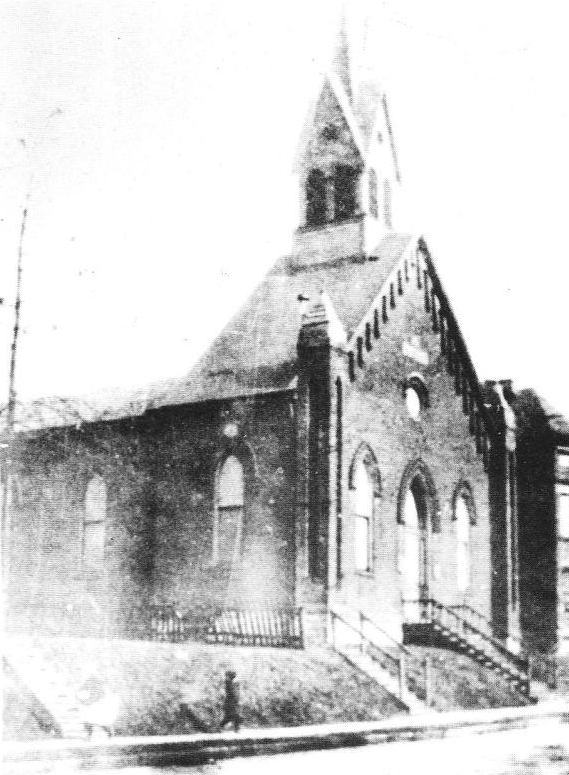
“This is South Avenue Church,” 1982, Wilkinsburg Public Library Digital Archives
“The Methodist Church was located where the Baptist now stands and the quiet peach of the neighborhood was such that when on a summer day Mr. Core [Jesse F. Core, pastor, 1887] in a loud voice would teach the peoply of holy things Tom the macaw of Dr. Semple’s would answer him much to the amusement of the congregation and the neighborhood.”
–Sue Duff Jackson
“By 1887 the growth of the community had been such that the Borough of Wilkinsburg was incorporated, and it is interesting to note that the first Burgess of the new Borough was the Rev. Charles W. Smith, D.D., then editor of the Pittsburgh Christian Advocate, and later elected one of our Bishops. His family were members of our church. Three of the six members of the first Borough Council were James A. Wilson, Richard W. Beatty and George W. Eagye, all official members of this church.”
–Vernon R. Covell
“The growing congregation made it imperative that there should be additional room, and ground was purchased on South Avenue at the site of the present building and a new and larger structure was erected in 1892–1893 at a cost of $35,000. The Sunday School wing was on the north side as in the present building, the school auditorium opening into the sanctuary with a large arch, closed with heavy draperies. There was a separate room for the small children, a library and two separate class rooms, all on one floor. The Johnson Pipe Organ was operated by a water motor, with auxiliary hand power, which used to come into action now and then when the motor failed. The Epworth League furnished the lighting fixtures, and the hymn books for the Sunday School; the Sunday School, the carpet and furniture for their rooms; the Ladies' Aid Society, the carpet for the sanctuary, the art glass windows, the pulpit furniture and the church, hymnals; and through the efforts of Warren Wilkins, money was raised for the new bell. There were several memorial windows, but the names of the donors are not available.”
–Vernon R. Covell
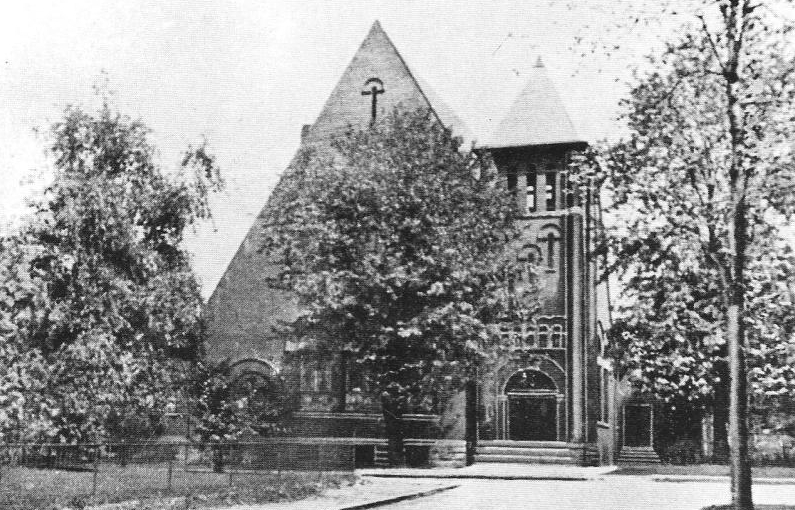
“This is South Avenue Church,” 1982, Wilkinsburg Public Library Digital Archives
“When the Methodist Church was moved to South Avenue like Boston we had a street that was called the way to heaven, for South Avenuue was beautiful with the trees that filled the prospect and nodded and murmured in the wind and had a charm and power to sooth.”
–Sue Duff Jackson
An architectural historian describes the church as a bold Richardsonian romanesque with round arches, a single a-frame gable front, and a tower with round buttresses.
“The growth of the Sunday School had been such that added facilities were found necessary and alterations and additions were made in 1901. The first floor of the Sunday School wing was extended and a second floor was added to the east and west side rooms. At the same time two rooms were added to the newly acquired parsonage. During the next several years the sanctuary became so crowded that the school auditorium was often used for the overflow. The sanctuary could not be enlarged and the building was too new to be torn down. At this juncture the need of a church in the neighborhood of Swissvale Avenue and Laketon Road seemed imperative and there was also a strong movement to relieve the congestion at the mother church by erecting a new building near enough to accomplish this end. This resulted in the building of the James Street Church and the Ross Avenue Church in 1905. South Avenue Church furnished the lot for the Ross Avenue Church at a cost of $7,000.”
–Vernon R. Covell
After the organization of the Mifflin Avenue Episcopal Church in 1896, the name Wilkinsburg Methodist Episcopal Church was changed to South Avenue Methodist Episcopal Church to prevent confusion.
“Then came the fire at 5:30 Saturday afternoon Feb. 23, 1907. The fire started in the basement from undetermined causes and everything combustible was destroyed . . . the blaze found the pipe organ, and chimneys of roaring flame shot toward the sky. That evening 23 members of the Official Board met in Father“s office after hours with Dr. James Mechem the District Superintendent presiding in place of our minister, Dr. Theadore N. Eaton who was seriously ill in a sanitarium at Clifton Springs, N.Y.”
–Edna Rigg Brown
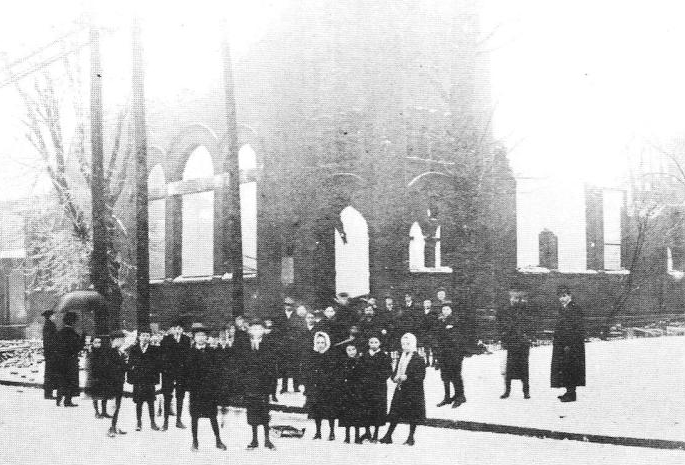
“This is South Avenue Church,” 1982, Wilkinsburg Public Library Digital Archives
“Officers from five churches and the Pennwood Club had poured in for us to use their buildings. It was arranged to hold the services in the Pennwood Club rooms, now the Y.M.C.A. on Ross Ave. and the midweek service in the Second Presbyterian Church. Rev. Burr McKnight was to be our substitute pastor. On Sunday morning there were 150 at Sunday School and the auditorium was completely filled for the church service. They took up a subscription toward the new church that morning and the generosity of the people was amazing. The Ladies Aid increased in size and held a week long bake sale in the newly completed store room at the comer of Rebecca and Hay which Dr. Earl Gray donated for the week. Mrs. J.E. Rigg was then the president. I have no record of the funds taken in, but do have a strong recollection of the 8 loaves of bread and the five gallon crock of beans Mother baked each night for the sale the next day, beside the pies, cakes and cookies Aunt Ella Rigg and we girls baked during the day and after school.”
–Edna Rigg Brown
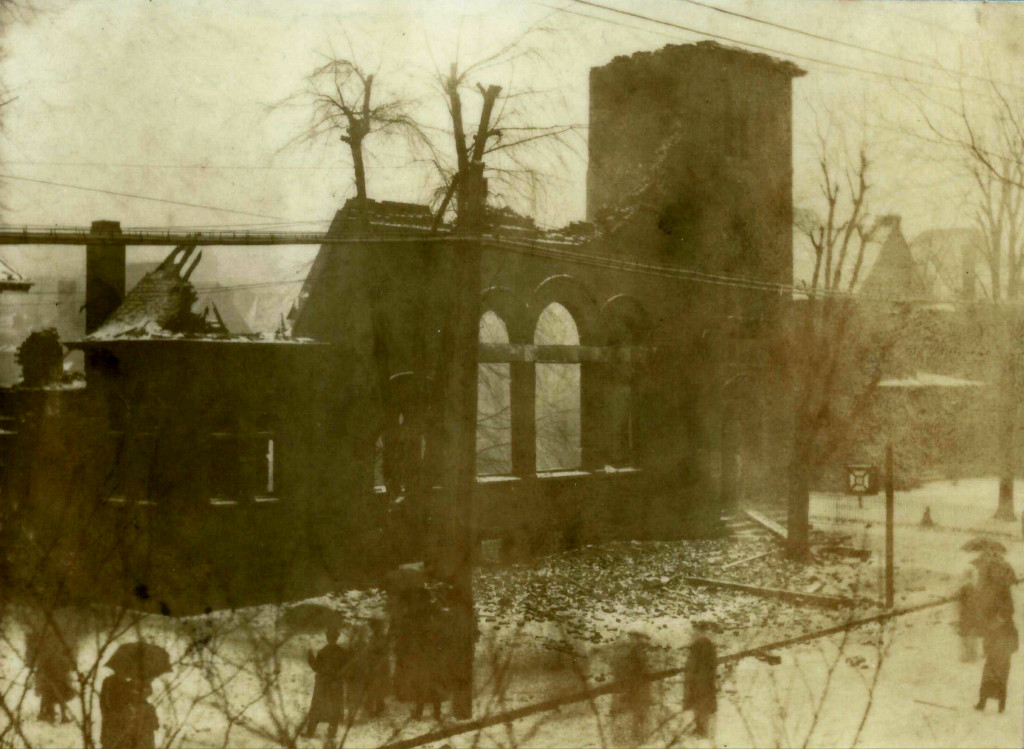
“The corner stone was laid Sept. 29 of that year and the Sunday School part of the building was occupied for Easter Sunday, April 19, 1908 and the complete structure was dedicated by Bishop Joseph H. Berry Feb. 21, 1909, just two years after the fire.”
–Edna Rigg Brown
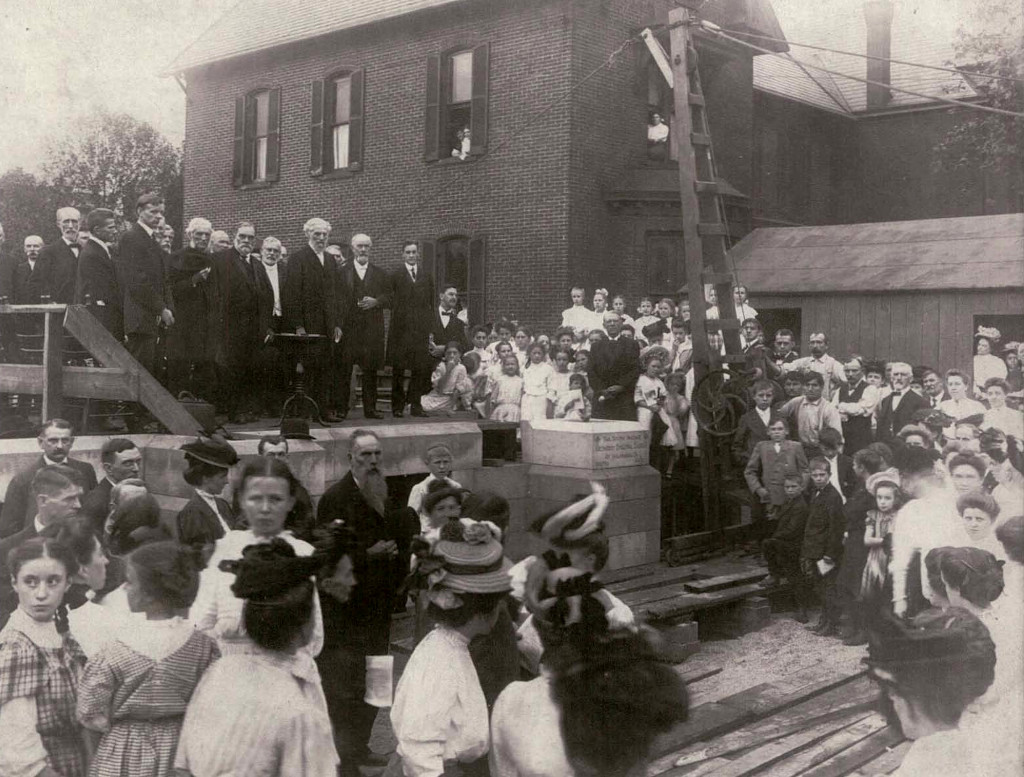
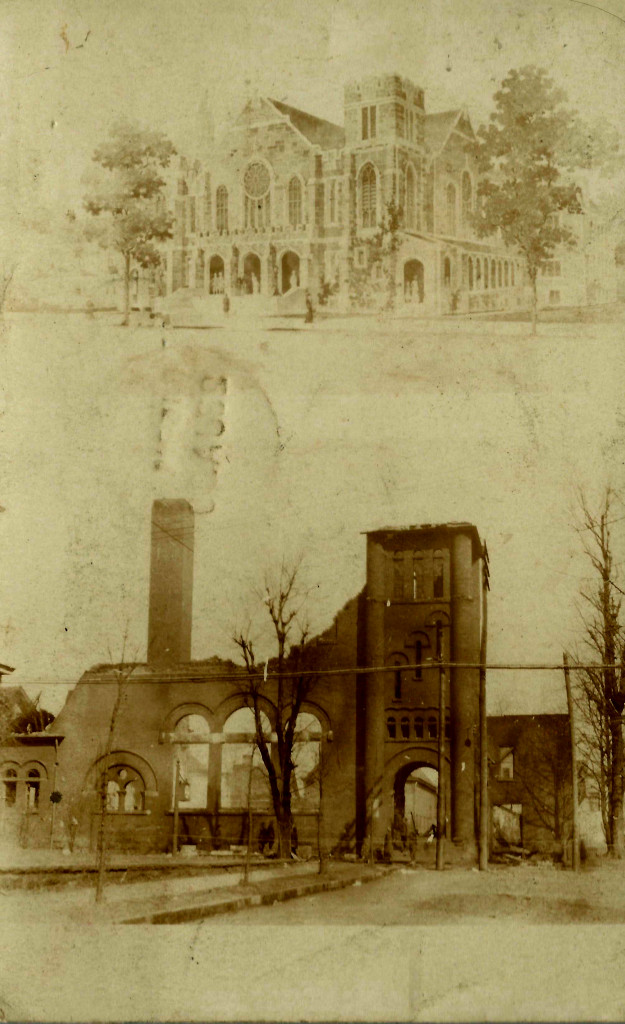
“The cloisters on either side lead in a dignified way to the church office and the church school units, and add very materially to the appearance of the building. At the suggestion of Dr. John E. Rigg, Chairman of the Building Committee, provision was made for a chorus choir of fifty voices and the new, three manual Kimball organ put our music activities on an entirely new plane. ”
–Vernon R. Covell
“The first wedding held there was Oct. 13, 1909 when Lida Rigg and Dr. J. Van Ballantyne were married.”
–Edna Rigg Brown
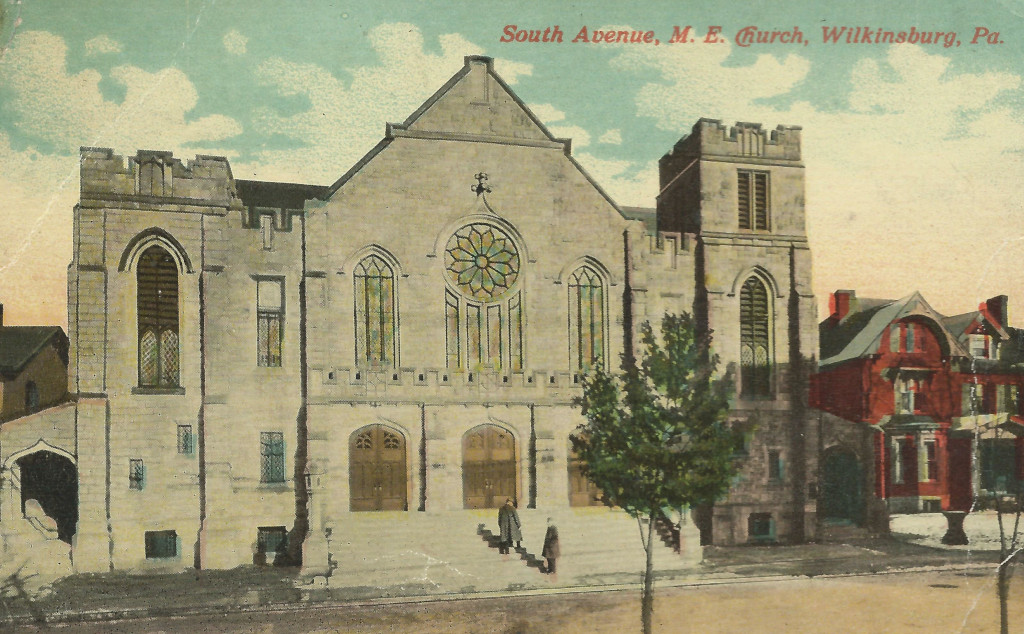
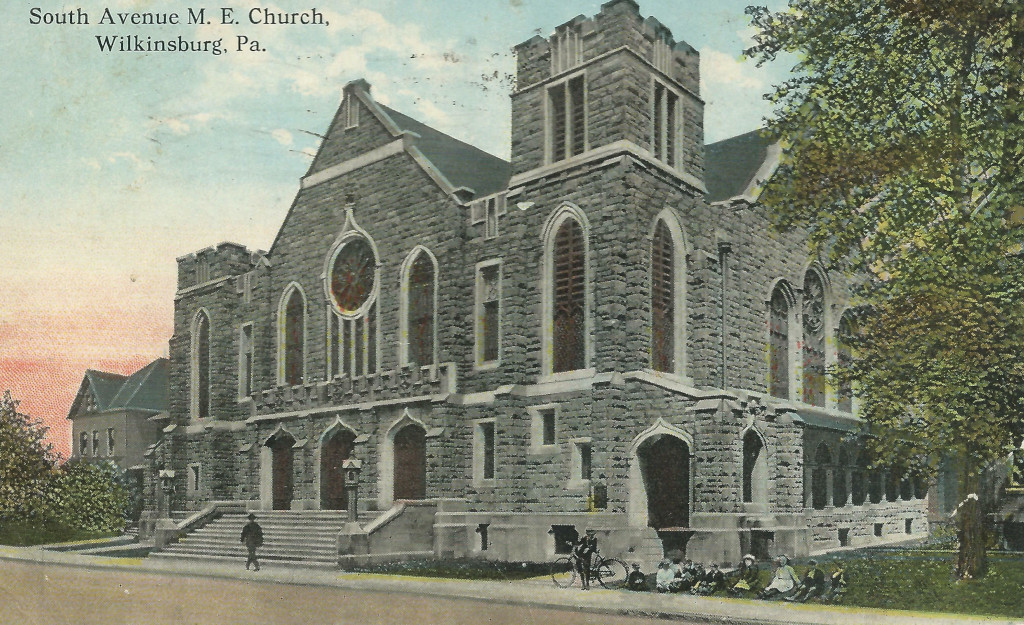
The congregation dedicated a three-story Sunday school wing in November 1923.

In 1939, the Methodist Episcopal Church, the Methodist Episcopal Church, South, and the Methodist Protestant Church denominations all united to form the Methodist Church. The congregation name changed from South Avenue Methodist Episcopal Church to South Avenue Methodist Church.

When the denominations of the Methodist Church and the United Brethren Church merged, the South Avenue Methodist Church became the South Avenue United Methodist Church in 1968.
The South Avenue, Ross Avenue, and Christ United Methodist Church congregations voted to merge into one congregation meeting at South Avenue beginning July 1, 1989.
______
Wilkinsburg Public Library Digital Archives:
Sue Duff Jackson, “Old Wilkinsburg,” Wilkinsburg Historical Society.
“Three Methodist churches combine,” The Gazette May 24, 1989, p. 3.
Edna Rigg Brown, “ ‘I Remember’ South Ave. Methodist Church,” June 19, 1961, at the Wilkinsburg Historical Society.
Vernon R. Covell, ”Methodism in Wilkinsburg“ in ”1843–1943 A Century of Christian Service, South Avenue Methodist Church,“ 1943.